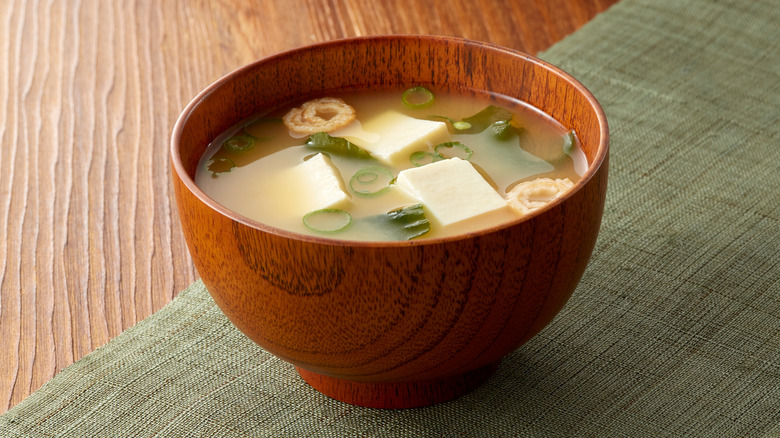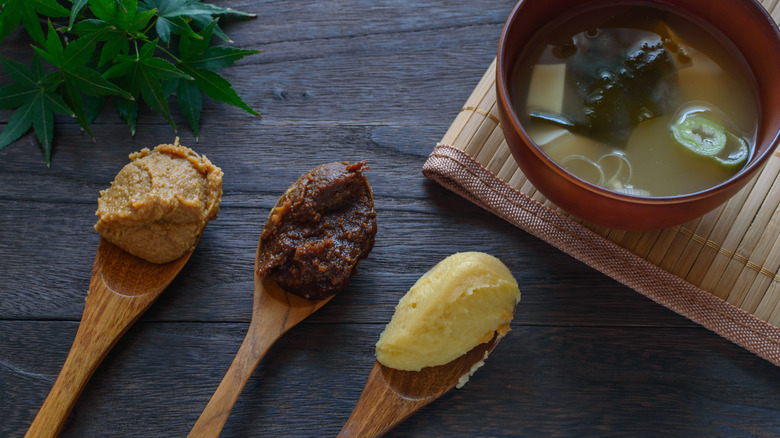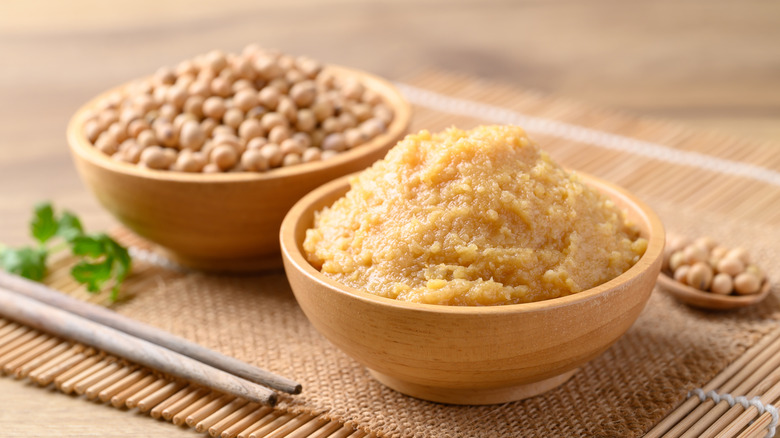How To Choose The Right Paste For That Perfect Bowl Of Miso Soup
There's nothing quite as soothing as a warm bowl of miso soup. Brimming with umami, it's often topped with silken tofu, wakame seaweed, and fresh green onions. The core ingredients of miso broth are dashi stock and miso paste, a fermented blend of soybeans, salt, and koji (a type of fungus). The most common categories of miso paste are white, red, and yellow. Each has a different taste and intensity that affects the overall flavor profile of the soup. To find out which is best for a perfect bowl of miso soup, Food Republic consulted Maricel Gentile, owner of Maricel's Kitchen and author of "Maricel's Simply Asian Cookbook," who explained, "For the traditional bowl of miso soup most people know, I usually use white miso or sometimes a blend of white and yellow."
The color and strength of miso paste depend on the fermentation time. "White miso, or shiro miso, is the lightest and sweetest. It has a short fermentation and tastes almost creamy." She added, "Yellow miso is a little stronger, with more tang and a nice balance of sweet and salty." Together, these create a balanced soup whose flavor is not too overwhelming, making it a perfect starter or a gentle accompaniment to a meal.
"Red miso is wonderful too, but it makes a stronger soup," Gentile advised. While it may not work in a classic, light miso soup, "I like to use it when I add hearty ingredients like mushrooms, root vegetables, or even pork," she told us. "[Red miso] ferments the longest, so it is salty, rich, and very deep in flavor, almost like aged cheese."
When to use different types of miso pastes
The type of miso paste you use depends on what you want from a dish. Beyond soup, miso paste can also be used in marinades, salad dressings, or even baked goods. According to Maricel Gentile, white miso is "light and fresh, perfect with greens, tofu, or seafood." It has a higher proportion of rice koji than other pastes, which breaks down the starches into sugars during fermentation. This makes it ideal for baking sweet desserts like white miso peanut butter cookies or even adding to spicy cocktails, as its lower saltiness and natural sweetness complement the flavors without overwhelming them. A spicy bloody Mary mix with a teaspoon of white miso mixed in? Yes, please.
Yellow miso "is balanced and cozy, good with grains, chicken, or squash." Whereas white miso is made with a higher proportion of rice, and red miso is made with a higher proportion of barley, yellow miso is usually a mixture of both. This allows its flavor profile to sit comfortably between the light, sweet flavors of white miso and the strong, bold flavors of red miso, making it exceptionally versatile for everyday cooking, as it adds a gentle savory touch to everyday meals without overpowering the flavor profile.
Red miso has a much stronger, deeper flavor than white or yellow pastes. Its fermentation can take years, providing plenty of time for complex flavors and aromas to develop. It also contains a higher proportion of soybeans, contributing to its robust taste. While its bold flavors make it less suitable for lighter dishes, Gentile described red miso paste as "deep and warming, perfect with beef, mushrooms, or a stew."
Mistakes to avoid when using miso paste
The biggest threat to the flavor of miso paste is heat. According to Maricel Gentile, "The mistake I see most often is people boiling miso right in the pot. High heat kills its living cultures and flattens the taste." These living cultures are the beneficial microorganisms that develop during fermentation, responsible for both miso's complex flavors and its nutritional benefits. As Gentile put it, "Miso is alive, so treat it gently. It is like the final touch of soul you add to the soup." Because of its probiotics, we recommend spending a little extra on high-quality miso to preserve its flavor and potential nutritional benefits. A little miso goes a long way, so one pot should last you a good while.
Another important tip to remember is that miso does not dissolve well in water. First, let the flavors of your water or dashi stock, and additional ingredients boil together. Then, "Scoop a little hot broth into a small bowl, whisk the miso until smooth, then stir it back into the soup at the very end, off the heat. That way the flavor stays alive and bright," Gentile advised. Alternatively, you could also turn off the heat and push a clump of miso directly through a strainer. Remember — less is always more. Even white miso can quickly become overwhelming if used too liberally. For a standard ratio, one to two tablespoons of miso per cup of dashi or water is ideal.



